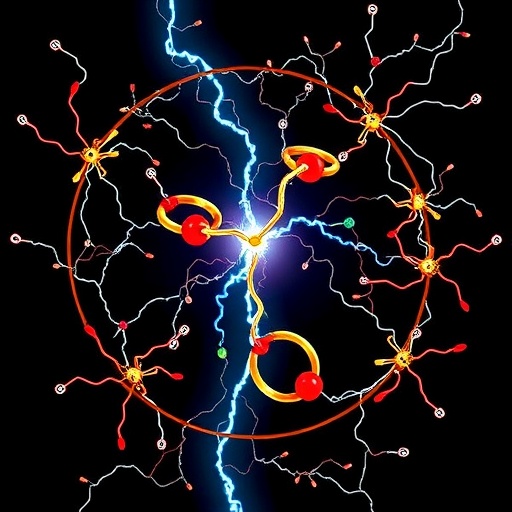
In a groundbreaking study poised to reshape our understanding of metabolic disease, researchers have unveiled a precise molecular mechanism by which obesity disrupts liver metabolism through alterations in mitochondrial reactive oxygen species (mROS) production. While reactive oxygen species within mitochondria have long been recognized as pivotal signaling molecules in physiological processes, their dysregulation is increasingly implicated in the pathogenesis of numerous diseases. Despite extensive research, the exact origins and regulatory mechanisms behind pathological mROS generation in vivo have remained elusive—until now.
Central to this discovery is the role of coenzyme Q (CoQ), a lipid-soluble electron carrier residing within the mitochondrial inner membrane, which shuttles electrons between complexes in the electron transport chain (ETC). The balance between its reduced form, ubiquinol (CoQH2), and its oxidized form (CoQ) is critical for maintaining redox homeostasis within mitochondria. The research team has demonstrated that in obesity, hepatic CoQ biosynthesis is impaired, leading to a skewed increase in the CoQH2/CoQ ratio. This imbalance drives excessive mROS production via a process known as reverse electron transport (RET) at a specific active site (site IQ) on complex I of the ETC.
The phenomenon of reverse electron transport represents an intriguing bioenergetic event wherein electrons flow backward through complex I, a deviation from the canonical unidirectional electron flow. RET is known to be a potent driver of mROS generation under certain physiological conditions but has not previously been characterized as a pathological driver in metabolic disease. By leveraging sophisticated genetic models and pharmacological interventions in vivo, the authors provide robust evidence that excessive RET-derived mROS is not merely a byproduct, but a causative factor mediating metabolic disruptions observed in obese states.
.adsslot_VtCP8cvdbs{width:728px !important;height:90px !important;}
@media(max-width:1199px){ .adsslot_VtCP8cvdbs{width:468px !important;height:60px !important;}
}
@media(max-width:767px){ .adsslot_VtCP8cvdbs{width:320px !important;height:50px !important;}
}
ADVERTISEMENT
Detailed examination of liver tissue from obese experimental models revealed a significant downregulation of the CoQ biosynthetic pathway, contributing to CoQ scarcity despite increased abundance of its reduced counterpart. This imbalance tips the redox environment within mitochondria toward excessive electron pooling at site IQ, potentiating RET and consequentially surging mROS emission. Notably, targeted inhibition of RET ameliorated metabolic abnormalities, underscoring the therapeutic promise of modulating this pathway.
Of particular translational relevance, human liver biopsies from patients exhibiting steatosis mirrored these findings. The hepatic CoQ biosynthetic program suppression correlated with increased CoQH2/CoQ ratios, which in turn paralleled disease severity markers. This tight association between CoQ redox imbalance, RET-induced mROS production, and human metabolic pathology elevates the potential for CoQ-centric interventions to restore mitochondrial function and preserve metabolic homeostasis in clinical populations.
The study also addresses a crucial gap in mitochondrial biology and disease research. While mROS generation has been identified as a double-edged sword capable of both beneficial signal transduction and deleterious oxidative damage, the mechanisms that specify its source remain insufficiently resolved. By pinpointing CoQ imbalance-induced RET as a highly selective and tunable source of pathological mROS, this research provides a blueprint for distinguishing physiological versus pathological ROS signaling contexts at the molecular level.
Importantly, the investigators harnessed several independent experimental modalities, including conditional genetic knockouts of CoQ biosynthetic enzymes and pharmacological compounds designed to modulate electron flow and CoQ redox status. These complementary strategies revealed that fine-tuning the CoQ redox ratio can directly influence the magnitude of RET and consequent ROS production, highlighting a previously unappreciated axis of mitochondrial regulation exploitable for therapeutic benefit.
The implications of these findings extend beyond obesity and steatosis. Aberrant mitochondrial function and mROS dysregulation are common denominators across a spectrum of disorders ranging from neurodegenerative diseases to cardiovascular pathologies. Thus, interventions aimed at correcting CoQ biosynthesis or modulating RET activity may represent a versatile therapeutic avenue with broad applicability.
Moreover, this study catalyzes a paradigm shift in our approach to mitochondrial-targeted therapies. Rather than blanket antioxidant strategies, which have largely failed to demonstrate consistent clinical efficacy, selective targeting of RET-induced mROS production based on precise biochemical profiling of CoQ redox states offers a more nuanced and potentially effective strategy for restoring metabolic equilibrium in disease.
Given that CoQ supplementation is already employed for certain mitochondrial disorders, the newfound connection between CoQ redox imbalance, RET, and liver metabolism suggests that future refinement in CoQ formulatory design or adjunct RET inhibitors could substantially enhance clinical outcomes. Rigorous clinical trials will be essential to translate these mechanistic insights into tangible benefits.
Fundamentally, this discovery enriches our understanding of the intricate network through which mitochondrial metabolism interfaces with cellular health and disease. By elucidating how CoQ redox dynamics can pivotally control pathological mROS generation through RET, we are gaining unprecedented clarity on the pathophysiology of metabolic diseases and opening pathways toward innovative, mitochondria-focused therapeutic interventions.
As metabolic disorders continue to escalate globally, discoveries like this underscore the importance of integrating molecular biochemistry with clinical insights to decode disease mechanisms. The precise delineation of CoQ-dependent RET as a pathological driver in obesity-induced liver dysfunction offers both a molecular biomarker for disease progression and a therapeutic target capable of restoring metabolic homeostasis.
In summary, this landmark research reveals that impaired hepatic CoQ biosynthesis in obesity leads to an increased CoQH2/CoQ ratio, which in turn promotes pathological mROS production through reverse electron transport at complex I. These findings not only unravel a critical mechanistic link between mitochondrial function and metabolic disease but also highlight promising avenues for targeted interventions aimed at preserving liver health in the context of obesity and steatosis.
Subject of Research: Mitochondrial reactive oxygen species generation via CoQ imbalance and reverse electron transport in obesity-related liver metabolism
Article Title: CoQ imbalance drives reverse electron transport to disrupt liver metabolism
Article References:
Goncalves, R.L.S., Wang, Z.B., Riveros, J.K. et al. CoQ imbalance drives reverse electron transport to disrupt liver metabolism. Nature (2025). https://doi.org/10.1038/s41586-025-09072-1
Image Credits: AI Generated
Tags: bioenergetics and mitochondrial functionCoenzyme Q imbalance and metabolic diseaseCoQH2 and CoQ ratio significanceelectron transport chain complex Ihepatic CoQ biosynthesis impairmentimplications of mROS in diseasemitochondrial reactive oxygen species dysregulationobesity and liver metabolismpathological mROS generation in vivoredox homeostasis in mitochondriareverse electron transport mechanismsignaling molecules in physiological processes





